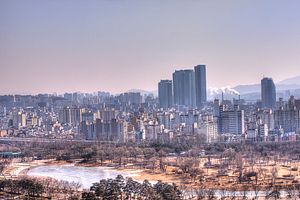By Kyle Ferrier
 The Moon Jae-in administration in South Korea is looking to spur strong, inclusive economic growth in 2020. Though that’s a perennial goal for Moon, the government has rolled out new plans in recent weeks in hopes of starting a struggling economy off on the right foot next year.
The Moon Jae-in administration in South Korea is looking to spur strong, inclusive economic growth in 2020. Though that’s a perennial goal for Moon, the government has rolled out new plans in recent weeks in hopes of starting a struggling economy off on the right foot next year.
The confluence of sluggish global and domestic factors has made this year a rough one for the South Korean economy. Trade tensions between Beijing and Washington have been a drag on global demand, but have hit South Korea particularly hard considering its overall reliance on exports and that China and the United States are its first and second largest export destinations, respectively. At home, ongoing efforts to bolster jobs and economic development have continued to fall short of high expectations. The end result is the expected real GDP growth rate of 2.0 percent this year, the lowest since the wake of the global financial crisis in 2009.
Despite the recent truce in the U.S.-China trade war, the projected growth numbers for next year are still historically low. South Korea’s Ministry of Economy and Finance (MOEF) is aspiring for 2.4 percent GDP growth next year, but others are less optimistic. The credit rating agencies Moody’s and Standard and Poor’s are currently predicting 2.1 percent growth for next year, while the IMF is only slightly more optimistic at 2.2 percent. Even if MOEF were to hit its numbers next year, it would mark the first time since at least 1954 that the country recorded back-to-back years of lower than 2.5 percent annual GDP growth.
Attempting to reinvigorate the economy next year, the Moon administration will redouble ongoing public sector-led efforts for innovative and inclusive growth. The first step was allocating more funding, which Moon’s Democratic Party pushed through the National Assembly earlier in December. The new budget of 512.3 trillion won ($434.4 billion) is up 9.1 percent from this year’s, with much of the increase going towards various fiscal stimulus and welfare programs.
In a series of press conferences on December 19, the government outlined new plans in more detail to meet growth targets. Moon announced that 100 trillion won ($86 billion) would be used for massive investment projects next year, including 23.2 trillion won ($20 billion) to improve infrastructure and to build new public buildings such as libraries and community sports centers. The government will further encourage private firms to invest 25 trillion ($22 billion) in large-scale projects, offering at least 10 trillion won ($8.6 billion) to help facilitate investment. On job creation, the administration has set aside 25.8 trillion won – 20 percent more than this year – and promises to provide tax incentives and other benefits to facilitate hiring. Incentives to boost consumption include lowering taxes for people who sell their old cars to buy new ones as well as extending tax cuts for electric and hydrogen vehicles. To help finance some of the increased costs, MOEF plans to issue about 10 trillion ($8.6 billion) in new government bonds next year.
However, the question still remains whether these and additional government-led initiatives along the same lines that are sure to come next year will be enough to move the needle in the right direction. Critics continue to argue that Moon’s policies still don’t do enough to account for business interests and therefore more of the same won’t get the country out of its economic doldrums. While there may be some merit to this argument, the influence of shifting external forces is likely having more of an adverse impact on the economy.
Strong global demand for semiconductors was a boon for the South Korean economy in recent years. Semiconductors represented 92 percent of export growth in 2018 and more than 80 percent of the current account surplus in 2017-2018. The drastic fall in chip prices starting in the second half of 2018, however, exposed the risk of overdependence on semiconductors. As much as chip sales abroad were a major driver of the economy, low prices significantly contributed to the expected 10.2 percent plunge in exports this year compared to last year, in turn dragging down South Korea’s export-dependent economy.
Viewed within this broader context, there are clear limitations to how much Moon’s policies can be held responsible for South Korea’s economic successes and struggles. This fact, however, won’t get him off the hook in the lead up to an important National Assembly election in April. How the government’s new initiatives play out early next year will likely play a key role in determining the sustainability of its economic agenda thereafter, but positive global economic developments could be just as, if not more, helpful.
No comments:
Post a Comment